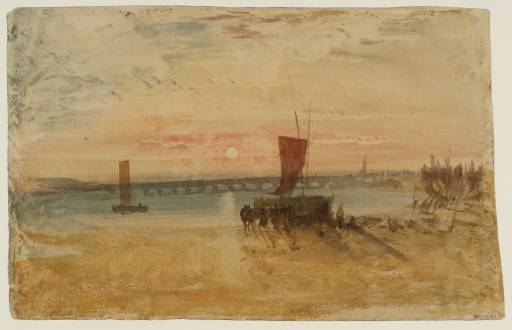Joseph Mallord William Turner Barnstaple Bridge at Sunset c.1814
Joseph Mallord William Turner,
Barnstaple Bridge at Sunset
c.1814
Joseph Mallord William Turner 1775–1851
Barnstaple Bridge at Sunset c.1814
D25443
Turner Bequest CCLXIII 320
Turner Bequest CCLXIII 320
Watercolour on white wove paper, 215 x 339 mm
Blind-stamped with Turner Bequest monogram bottom centre
Stamped in black ‘CCLXIII – 320’ bottom right
Blind-stamped with Turner Bequest monogram bottom centre
Stamped in black ‘CCLXIII – 320’ bottom right
Accepted by the nation as part of the Turner Bequest 1856
Exhibition history
1904
National Gallery, London, various dates to at least 1904 (780, as ‘Lake of Constance’).
1934
Watercolours from the Turner Bequest [Loan Series B], Public Gallery and Museum, Hove, December 1934–March 1935, Ferens Art Gallery, Hull, December 1948–January 1949, Celebration of the Centenary of Turner’s Death [Loan Series B], National Museum of Wales, Cardiff, February–March 1951 (no catalogue but frame no.15, as ‘Broad River with a many arched Bridge and Church Tower’).
1997
Turner’s Watercolour Explorations 1810–1842, Tate Gallery, London, February–June 1997, Southampton City Art Gallery, June–September (39, as ‘Barnstaple Bridge at Sunset’, c.1813, reproduced in colour).
2004
Turner and Williamson / In the Haze: Watercolours by Turner and Williamson, Clore Gallery, Tate Britain, January–May 2004, Lady Lever Art Gallery, Port Sunlight, June–August (no catalogue, as ‘Barnstaple Bridge at Sunset’).
2006
Light into Colour: Turner in the South West, Tate St Ives, January–May 2006, Plymouth City Museum and Art Gallery, May–August (no number, as ‘Barnstaple Bridge at Sunset, c.1813, reproduced in colour).
2007
Hockney on Turner Watercolours, Tate Britain, London, June 2007–February 2008 (not in catalogue).
References
1904
E.T. Cook and Alexander Wedderburn eds., Library Edition: The Works of John Ruskin: Volume XIII: Turner: The Harbours of England; Catalogues and Notes, London 1904, p.641 no.780, as ‘Lake of Constance’.
1820
A.J. Finberg, A Complete Inventory of the Drawings of the Turner Bequest, London 1909, vol.II, p.839, CCLXIII 320, as ‘Lake of Constance’, c.1820–30.
1813
Eric Shanes, Turner’s Watercolour Explorations 1810–1842, exhibition catalogue, Tate Gallery, London 1997, pp.28, 58–9 no.39, as ‘Barnstaple Bridge at Sunset’, c.1813, reproduced in colour, pp.94 Appendix I ‘Devonshire’, 102 Appendix I ‘Southern Coast of England Series’.
1813
Sam Smiles, Light into Colour: Turner in the South West, exhibition catalogue, Tate St Ives 2006, reproduced in colour p.47, p.55 no number, as ‘Barnstaple Bridge at Sunset, c.1813.
Until Eric Shanes identified the subject of this colour study in 1997, it went by the long-standing title ‘Lake of Constance’,1 presumably on account of its very slight resemblance to the scene in the 1842 watercolour Constance (York Art Gallery),2 showing the German city of Konstanz overlooking the Bodensee lake, along the Rhine on the German-Swiss-Austrian border; see also Tate D36142 (Turner Bequest CCCLXIV 288).
In fact, the scene is closer to home, focusing on the sixteen-arched bridge over the River Taw at Barnstable in North Devon. Turner had drawn it in the Devon Rivers, No.1 sketchbook (Tate D09550; Turner Bequest CXXXII 66),3 now dated to 1814, looking downstream to the north-west with the spire of the Church of St Peter and St Paul beyond; see also Tate D09549, D09551–D09555 (Turner Bequest CXXXII 65, 67–70a), the last of which shows a boat under construction, as incorporated on the right here.
Teignmouth, Devonshire, a watercolour of about 1813 (Yale Center for British Art, New Haven),4 engraved for the Southern Coast in 1815 (Tate impressions: T04380, T05376–T05384, T05968), is another estuary scene, with a low dawn sun and a boatyard on the right. While the present work shows a summer sunset, the compositions are rather similar, which may have stopped Turner developing the design for the same project5 (see the Introduction to this section). The glowing colour and waterside setting evokes Turner’s classical seaport paintings in the manner of Claude Lorrain (1604/5–1682), whom he greatly admired and often emulated.6 Compare for example The Decline of the Carthaginian Empire, exhibited in 1817 (Tate N00499),7 or Tate D25380 (Turner Bequest CCLXIII 257) in the present section.
Technical notes:
The sun was initially reserved, as was its reflection. Bands of cloud either side of it were lifted out of the red washes while wet. The sheet is somewhat yellowed overall from prolonged early display, fortuitously adding to the warm sunset effect.
Verso:
Blank; some adventitious specks of ochre watercolour; dark offsetting from a straight edge.
Matthew Imms
July 2016
How to cite
Matthew Imms, ‘Barnstaple Bridge at Sunset c.1814 by Joseph Mallord William Turner’, catalogue entry, July 2016, in David Blayney Brown (ed.), J.M.W. Turner: Sketchbooks, Drawings and Watercolours, Tate Research Publication, February 2017, https://www

